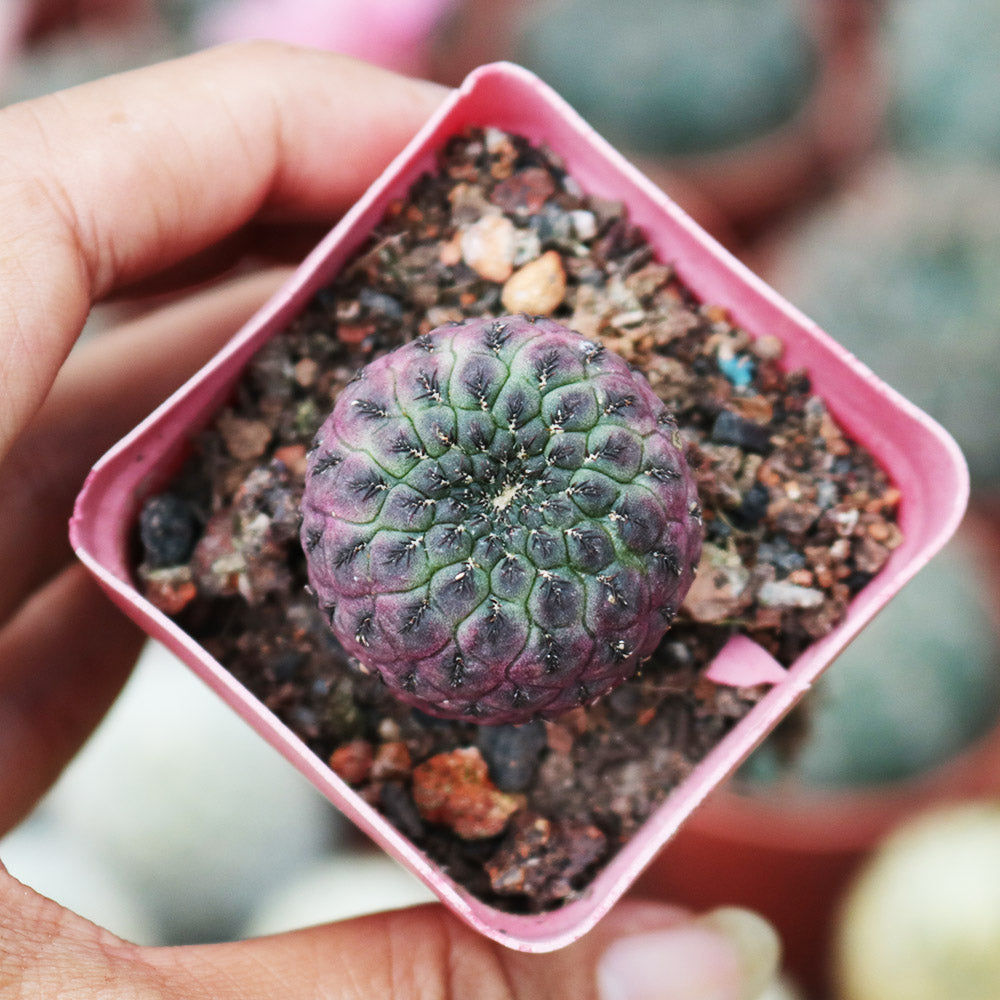This is a small-sized clumping variety (rarely solitary) that readily forms multiple heads. Sulcorebutia Rauschii have spine-like protrusions resembling fishbones.
Stem: The diameter is 3 (5) cm, and height is 2 (4) cm. The bulbs are covered with numerous flat protrusions (width 5mm), with color variations ranging from deep green to purple. Mature plants have 16 sets of spiral arranged protrusions starting from the top. Long and narrow thorn seats have white glandular hairs. There are 9-11 long 1-2mm short black peripheral spines, pointing downward at an oblique angle from the stem. They resemble fishbones.
Flower: Blooms in late spring, with flowers measuring 20-50mm in length and 35-5mm in diameter. The yellow-green funnel-shaped corolla has brown scales, while the petals are deep magenta, with the throat slightly darker.
Fruit: Reddish-brown with a diameter of 4-5mm.
Root: Conical.
Planting: Mountain-grown Echinocactus requires well-draining coarse sand and gravel substrate and good ventilation to avoid rot due to its slow growth rate and intolerance to excessive watering. It can also be grafted onto other plants to mitigate the risk of rot.
Transplanting: Requires a deep pot to accommodate the developed root system. Repotting with fresh soil is needed every year or when the pot becomes too small. However, this doesn't necessarily mean a larger pot is required. Surrounding the root neck with coarse sand and gravel aids drainage and prevents rot effectively.
Light: Partial shade for young plants, followed by full sunlight (with slight shading during the hottest summer days).
Cold resistance: Quite cold-resistant, tolerating temperatures down to -5 (-15)°C, but prefers winter temperatures around 0-10°C for dormancy, which is beneficial for plant health and flowering. Lack of low temperatures in winter may result in no flowers the following spring.
Watering: Moderate watering during the growing season, with watering once a week in summer or more frequently if evaporation is rapid, but always allowing the soil to dry completely between waterings for healthy growth. When temperatures start to drop in October, keep the soil dry, and ensure dryness throughout winter as the plant becomes fragile and cannot tolerate excess humidity. It can survive outdoors in winter without protection (enduring temperatures down to 5°C), but this increases the risk of root rot.
Fertilization: Use high-potassium nutrient solution during the growing season.
Propagation: Propagate via seeds, cuttings, or grafting. Select and dry cuttings thoroughly in spring or summer, then plant them in fresh soil suitable for Echinocactus. Keep the soil slightly moist until rooted. Sowing seeds on the soil surface is ideal, with germination occurring in 14-28 days at 20°C. Remember, seedlings do not tolerate strong light or dry conditions.
Pests: Susceptible to pests, especially under conditions without insects, such as cochineal insects and red spiders. Pay attention to stem and root pests like scale insects and mealybugs, which can lead to fungal infections. Look for patches of stem and root powdery defects, as they may indicate fungal attacks and damage.
